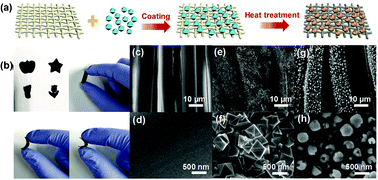Hollow core–sheath nanocarbon spheres grown on carbonized silk fabrics for self-supported and nonenzymatic glucose sensing†
Abstract
Flexible enzymatic glucose sensors have been investigated extensively for health monitoring systems. However, enzymatic glucose sensors have some problems, such as poor stability and complicated immobilization procedures. Rational and controllable design of nanomaterials with a unique structure, high activity and good electrochemical performance for nonenzymatic glucose sensors is desired critically. In this paper, we synthesize cuprous oxide nanoparticles embedded in carbon spheres directly on carbonized silk fabrics (Cu2O NPs@CSs/CSF), which is further used for the fabrication of a flexible and self-supported non-enzymatic glucose sensor. The Cu2O NPs@CSs/CSF shows good electrical conductivity due to the large contact area and the stable connection between the carbonized silk fabrics and carbon spheres. We demonstrate that the as-obtained non-enzymatic glucose sensor possesses high sensitivity and good stability, indicating its potential for practical applications. This strategy diversifies the toolbox available to the field of nonenzymatic glucose sensors and holds promise for flexible electronic devices.



 Please wait while we load your content...
Please wait while we load your content...